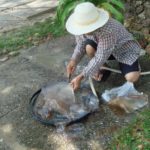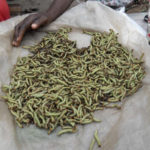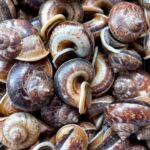Foreword
Horseshoe crabs are a species not protected in Thailand and are experiencing a significant decline. Their primary habitats, particularly the mudflats around mangrove forests, where they live and reproduce, are diminishing, and there is a growing demand for edible female horseshoe crabs as exotic cuisine. However, it is crucial to emphasize that this article does not endorse or encourage the unsustainable exploitation of these creatures. Instead, it aims to provide international readers with an overview of the historical significance of horseshoe crabs as a traditional food source. I firmly stand against removing even a single horseshoe crab from its ecosystem.
————————-
Despite being referred to as “crabs” in English, horseshoe crabs do not belong to the same subphylum as true crustacean crabs. Instead, they are classified under the taxonomic class Merostomata. This taxonomic classification places them closer to arachnids and scorpions than typical crabs.

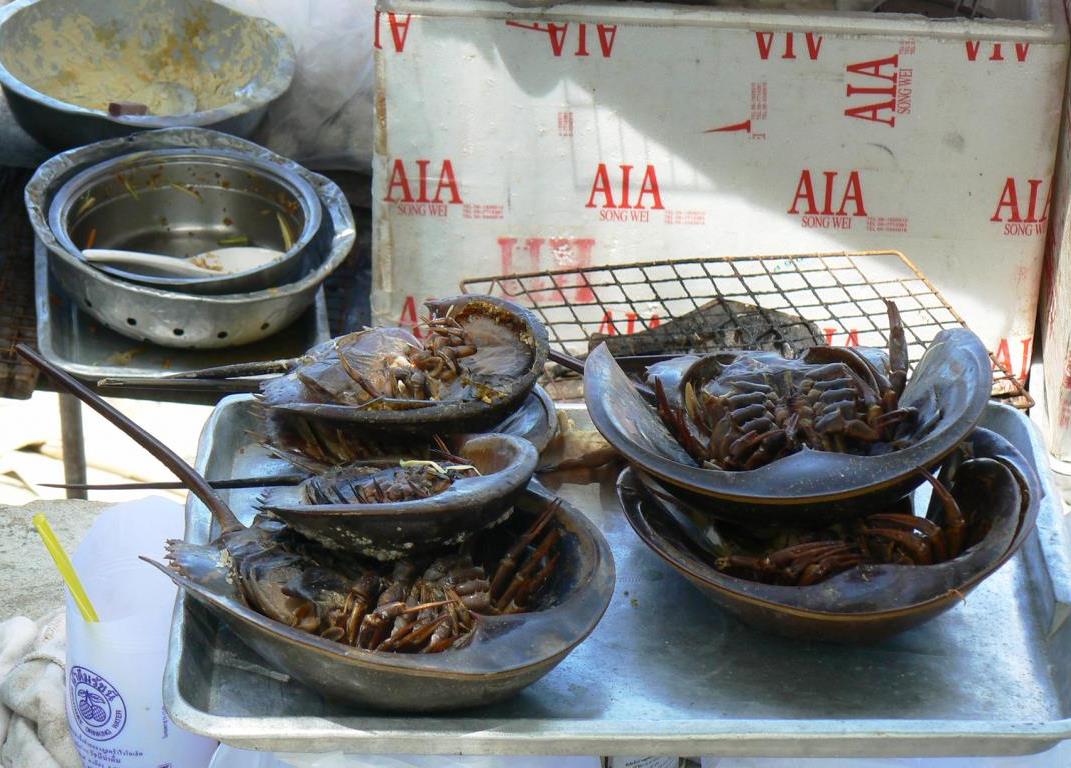
Horseshoe crab species and their distribution in Southeast Asia
There are four known living species of horseshoe crabs worldwide. Among these species, one, Limulus polyphemus, is found exclusively in Northern America, while the remaining three are native to various Asian regions. These Asian species include:
- Chinese horseshoe crab (Tachypleus tridentatus)
- Mangrove horseshoe crab (Carcinoscorpius rotundicauda)
- Indo-Pacific horseshoe crab (Tachypleus gigas)
Each species also has different common names within its respective regions. The accompanying figure provides a representation of its general distributions.
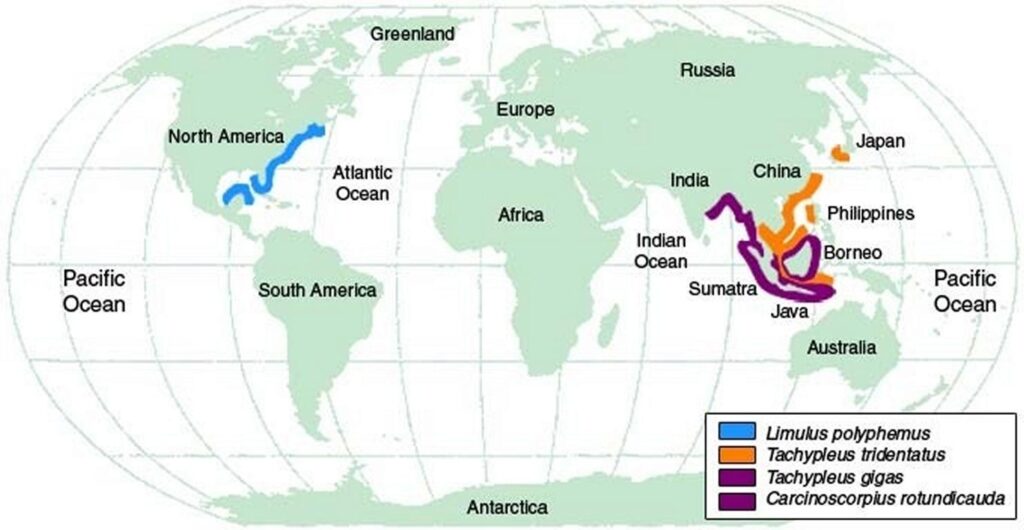
Humans mainly eat horseshoe crabs in Thailand and Malaysia. This publication shows the distribution of the three Asian horseshoe crab species.



All three pictures © St. Vestbo and M. Obst in the publication mentioned above.
The provided information reveals that only two species of horseshoe crabs are present in the two countries where they are consumed, Thailand and Malaysia. These species are the Mangrove horseshoe crab (Carcinoscorpius rotundicauda) and the Indo-Pacific horseshoe crab (Tachypleus gigas). Therefore, our discussion will focus specifically on these two species.
Which horseshoe crab species is poisonous?
The Mangrove horseshoe crab (Carcinoscorpius rotundicauda) has been found to contain lethal tetrodotoxin poison in the roe of females. This potent toxin is also present in other body parts of the species. Studies have shown that the highest concentrations of tetrodotoxin are typically observed in February to April, particularly within the eggs. However, it is crucial to note that not all individuals exhibit the same level of toxicity.
Due to the potential dangers associated with tetrodotoxin and other related poisons, it is strongly advised against consuming this species.
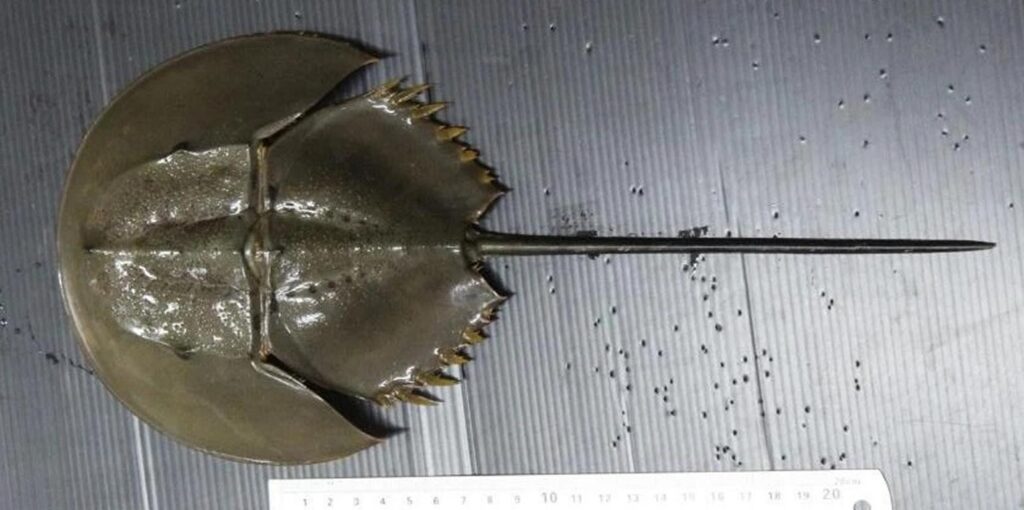
Poisonous Mangrove horseshoe crab (Carcinoscorpius rotundicauda). Picture from this source.
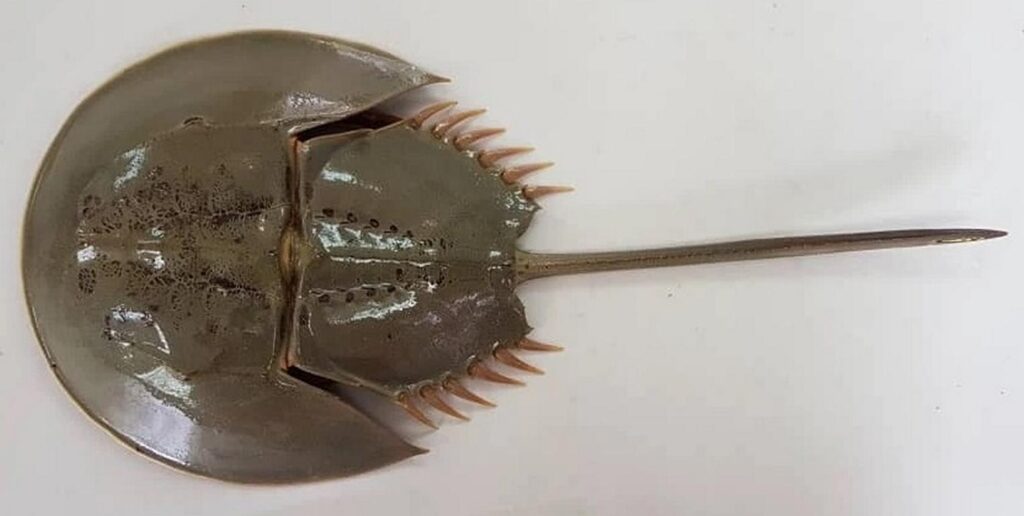
Indo-Pacific horseshoe crab (Tachypleus gigas) contains edible roe in females—picture from the same source as before.
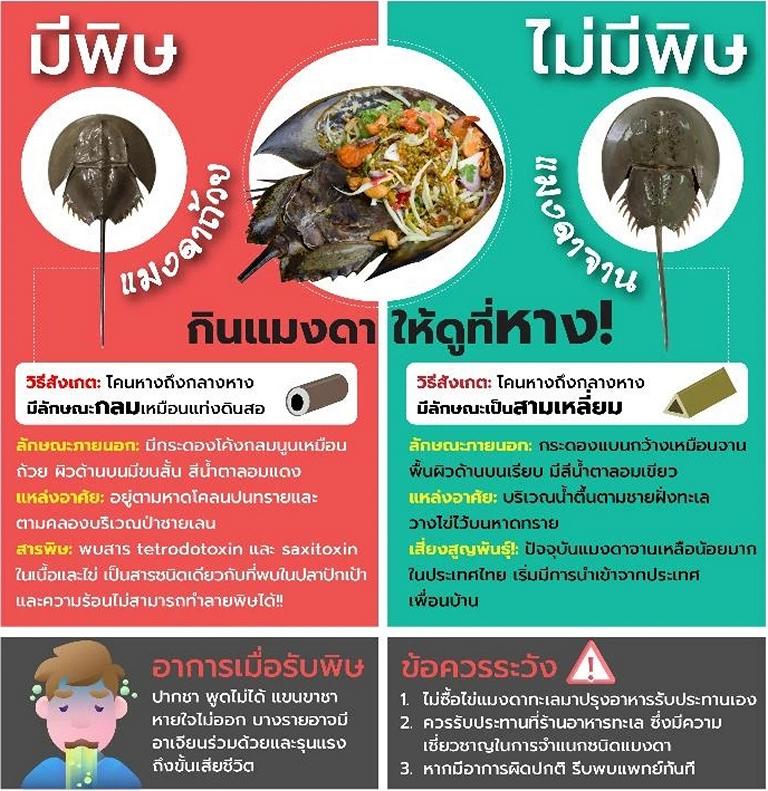
In Thailand, various health services have developed posters and brochures that compare the poisonous Mangrove horseshoe crabs (red color) to the edible Indo-Pacific horseshoe crabs (green color). These informational materials aim to raise awareness and educate the public about the distinct characteristics of these two species. An example can be found at this link.
In general, Tachypleus gigas (Indo-Pacific horseshoe crab) tend to be larger compared to the Mangrove horseshoe crab (Carcinoscorpius rotundicauda). However, distinguishing between these two species can be challenging as they share similar physical characteristics. To aid in differentiation, let’s briefly discuss the three main parts of a horseshoe crab: the head, abdomen, and tail (telson), and compare them for each species.
Head
The head of a horseshoe crab is characterized by a round chitinous structure located at the front of the animal. Multiple eyes are situated on the carapace, the hard upper shell, on the head’s top surface. The underside of the head contains pedipalps, which are used for feeding and movement.
When comparing the two species, the edible Indo-Pacific horseshoe crab typically has a greenish-brown coloration. Its head shape is dish-like and flat, with fewer curvatures on the upper surface. In contrast, the poisonous Mangrove horseshoe crab displays a reddish-brown coloration. Its head appears to be more elevated, resembling an ornamental pot.
Abdomen
The abdomen of a horseshoe crab is connected to the head through a cartilaginous hinge. Its carapace, similar to the head, is composed of chitin and has six spines on each rear side. When comparing the two species, Tachypleus gigas generally possesses longer spines on its abdomen compared to Carcinoscorpius rotundicauda. These spines of T. gigas often have a yellowish coloration.
In the case of T. gigas females, they typically have three long spines in the front and three shorter spines at the rear of their abdomen. However, it is worth noting that the length and arrangement of these spines may vary among individuals. Male T. gigas individuals, on the other hand, usually have spines of the same size throughout their abdomen.
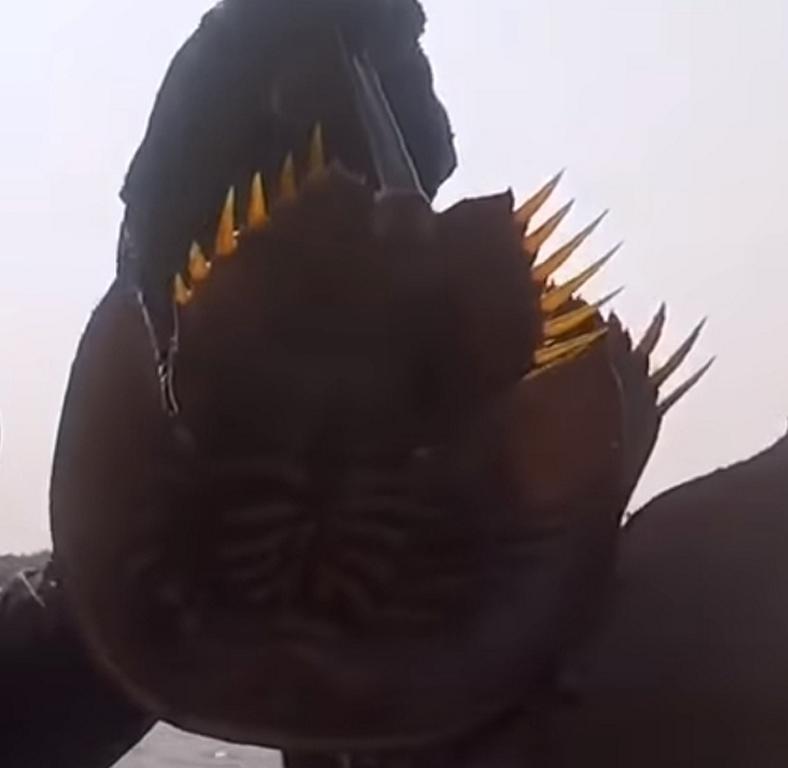

Yellow spines of T. gigas; Video still from that source.
The underside of a horseshoe crab is home to its book gills, which resemble the pages of a book when opened. Each flap of the book gills is comprised of two interconnected parts. The uppermost flap, known as the genital operculum, covers the genital openings where the genital pores are situated. The subsequent five flaps serve as both respiratory organs and aid in the crab’s movement or propulsion while navigating its surroundings.
How can you distinguish between male and female horseshoe crabs?
Due to the limited meat in horseshoe crabs, only their eggs are typically consumed. Upon catching a horseshoe crab, the first step is determining its sex. Males who do not produce eggs are promptly released. The process of determining the sex involves lifting the first flap, known as the genital operculum, and examining the size and hardness of the genital pores.
In the case of males, their genital pores will appear as a pair of small, hard pumps with a single round opening on top. In contrast, females will exhibit a pair of soft, large, and yellow sacs with a slit on top. This distinction allows for accurate sex identification, enabling the release of male horseshoe crabs while retaining the females for their eggs.
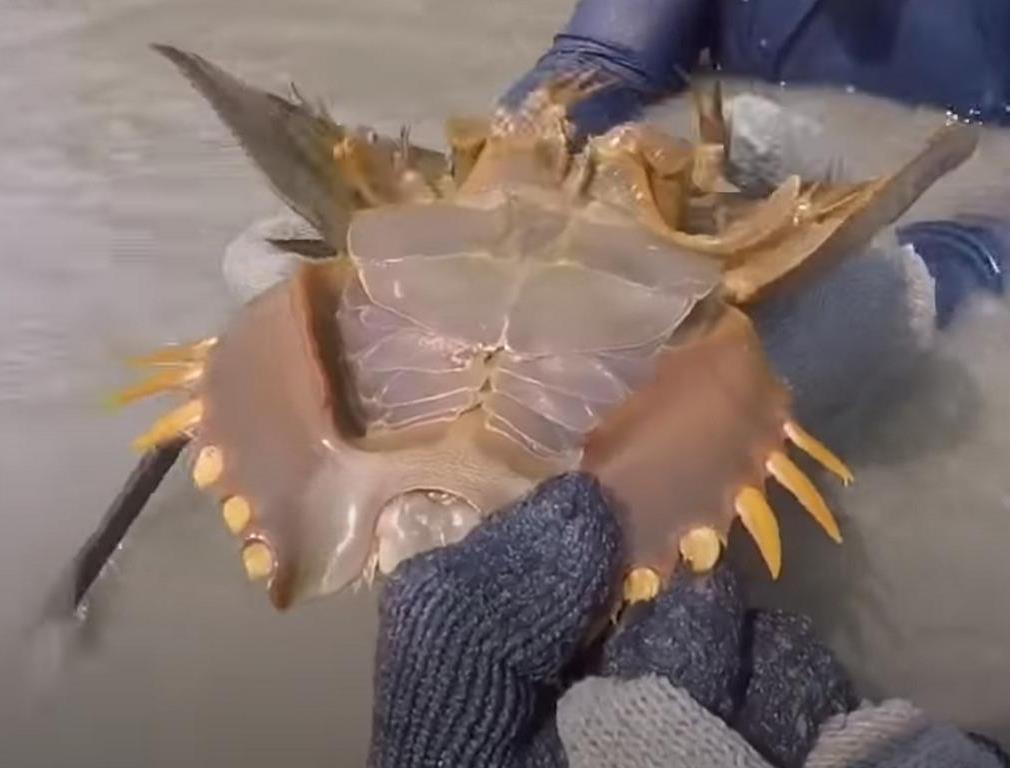
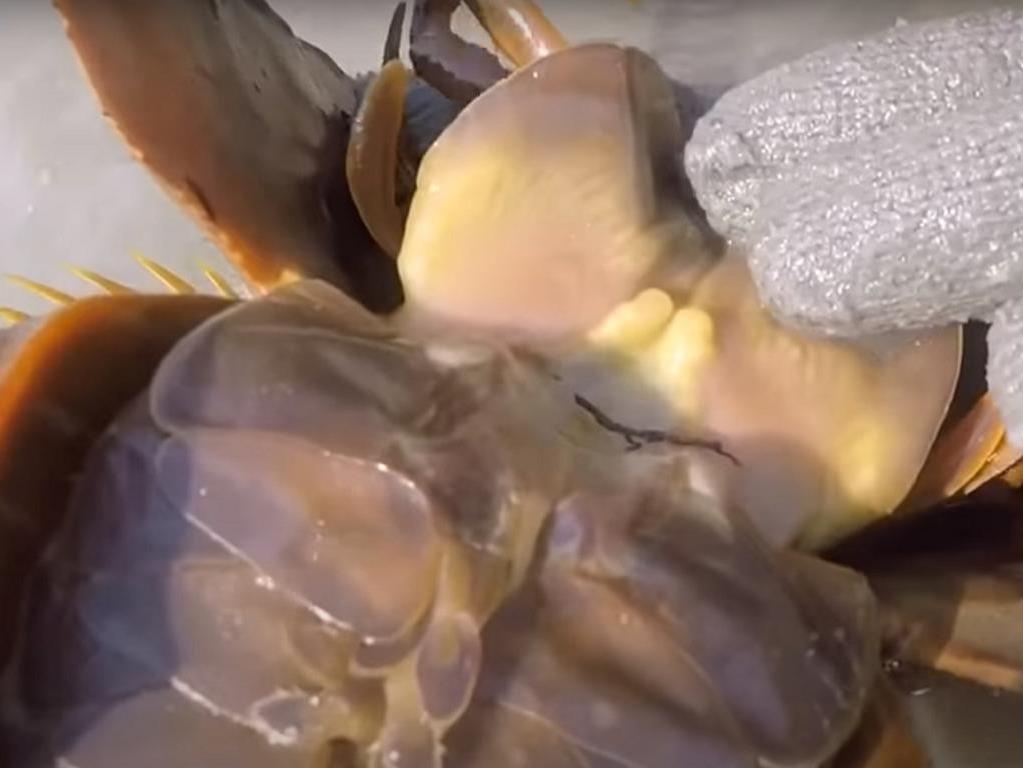
Book gills and genital pores of a female T. gigas; Video still from that source.
Tail
The most distinct differentiation between the two species lies in their tails. The poisonous Mangrove horseshoe crab possesses a round and leathery tail. At the same time, the edible Indo-Pacific species has a triangle-shaped chitinous tail with a serrated upper edge and a groove on the underside.
In Thailand and Malaysia, a simple method for determining the edibility of a horseshoe crab is to lift it by the tail. If the tail feels leathery, smooth, and comfortable to touch, it should be released immediately, as it indicates that it is a poisonous Mangrove species. Conversely, if the tail feels hard, rough, and coarse when lifted in these countries, it suggests that the horseshoe crab may be potentially edible.
How to catch Horseshoe crabs
In Malaysia, Tachypleus gigas, is listed as a protected species under the Fisheries Act 1985 and the Fisheries (Control of Endangered Species of Fish) Regulations 1999. These regulations prohibit the capture, possession, trade, and consumption of horseshoe crabs without proper permits or authorization.
In Thailand, horseshoe crabs are not currently specifically protected by law. Therefore, they are allowed to be caught and eaten. If somebody wants to catch them for culinary, educational, or research purposes, follow some general guidelines.
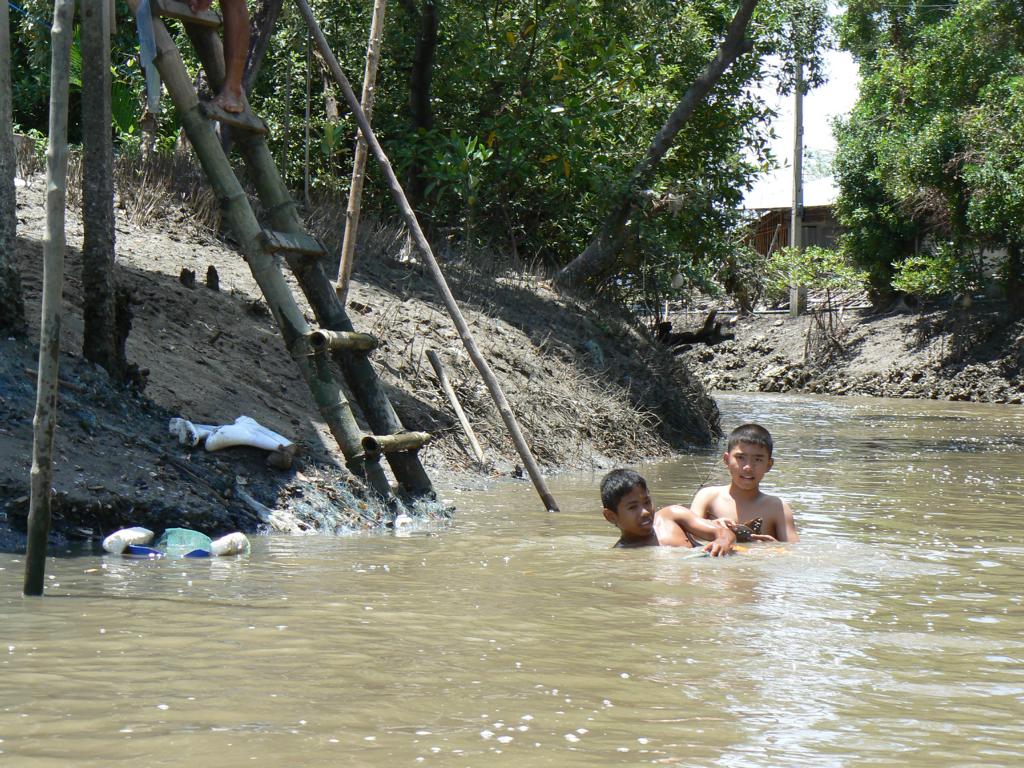
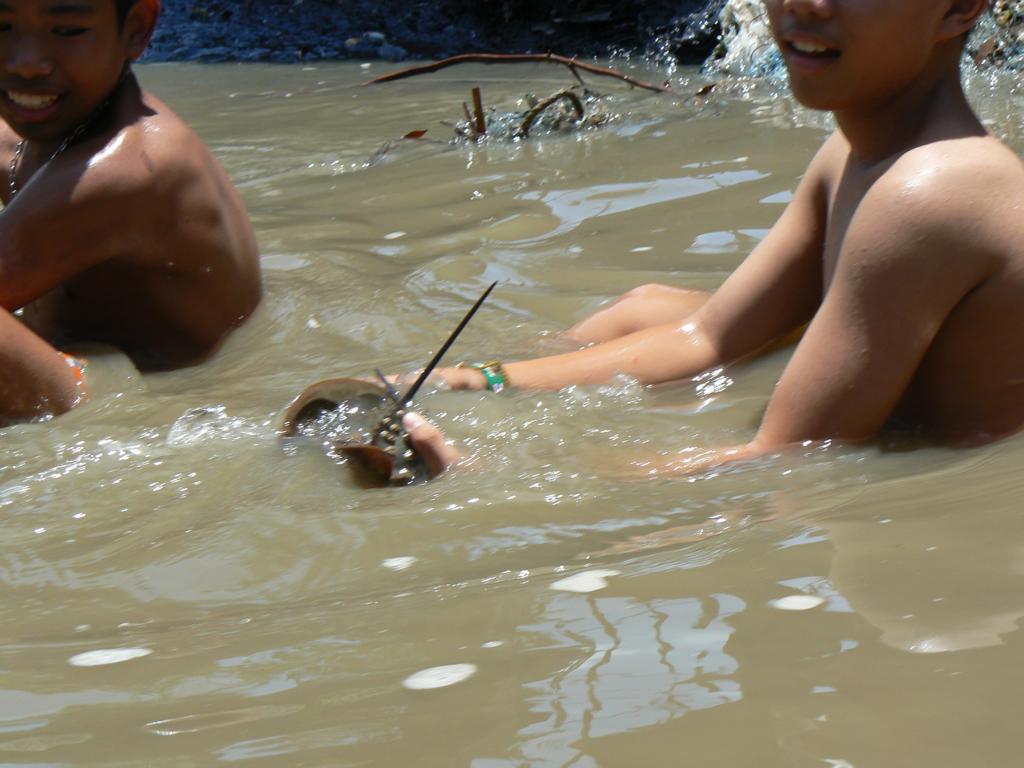
Timing and Location
Horseshoe crabs are typically found in shallow areas with sandy or loamy substrates near the water’s edge, including beaches, estuaries, and mudflats. During rising tides and around the full moon and new moon phases, they migrate closer to the shore for spawning activities. In Thailand, Indo-Pacific horseshoe crabs have a year-round spawning time, meaning they reproduce consistently throughout the year.
Catching techniques
Fishermen and fisherwomen in Thailand employ a unique method for capturing horseshoe crabs. They slide on their bellies through knee-deep, muddy waters, relying on their sense of touch to locate the horseshoe crab’s carapace outline using their hands. Once they contact a horseshoe crab, they press it down into the mud and lift it out.
After retrieving the horseshoe crab, it undergoes a brief wash to remove excess mud. The fishermen then proceed to open the first book gill, known as the genital operculum, to determine the sex of the individual. If it is determined to be a male, it is promptly released. However, if the horseshoe crab is identified as a female and its carapace diameter is at least one handspan wide, it is retained.
An alternative technique involves a small hook attached to a handle to catch the horseshoe crabs on their carapaces.
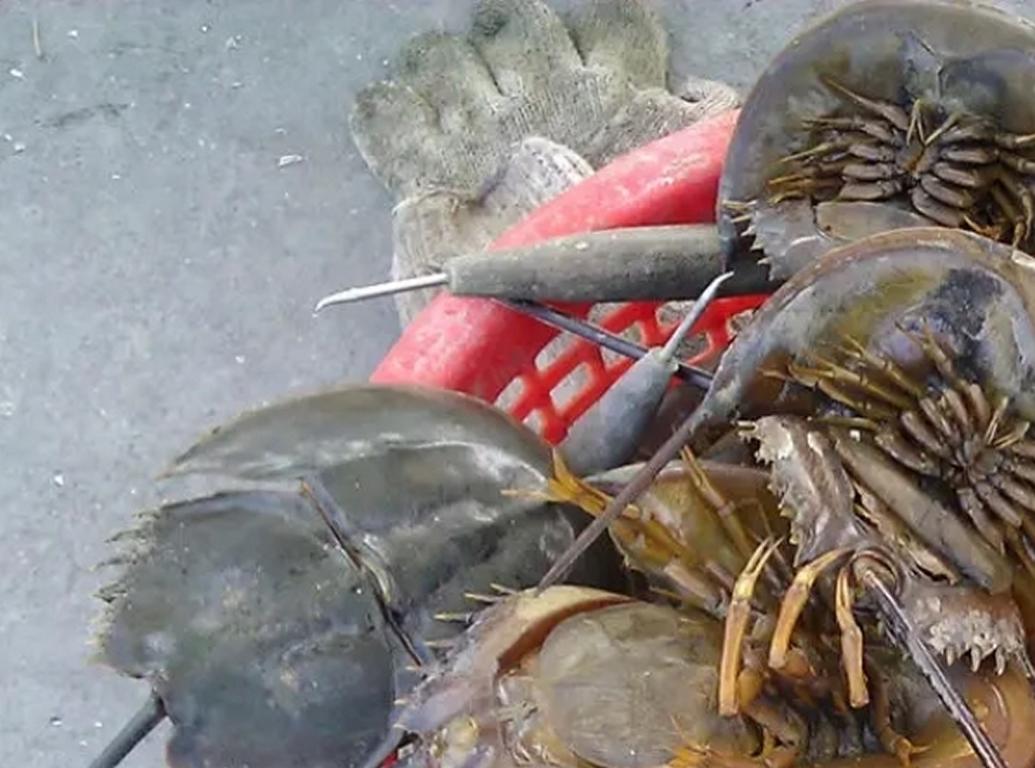
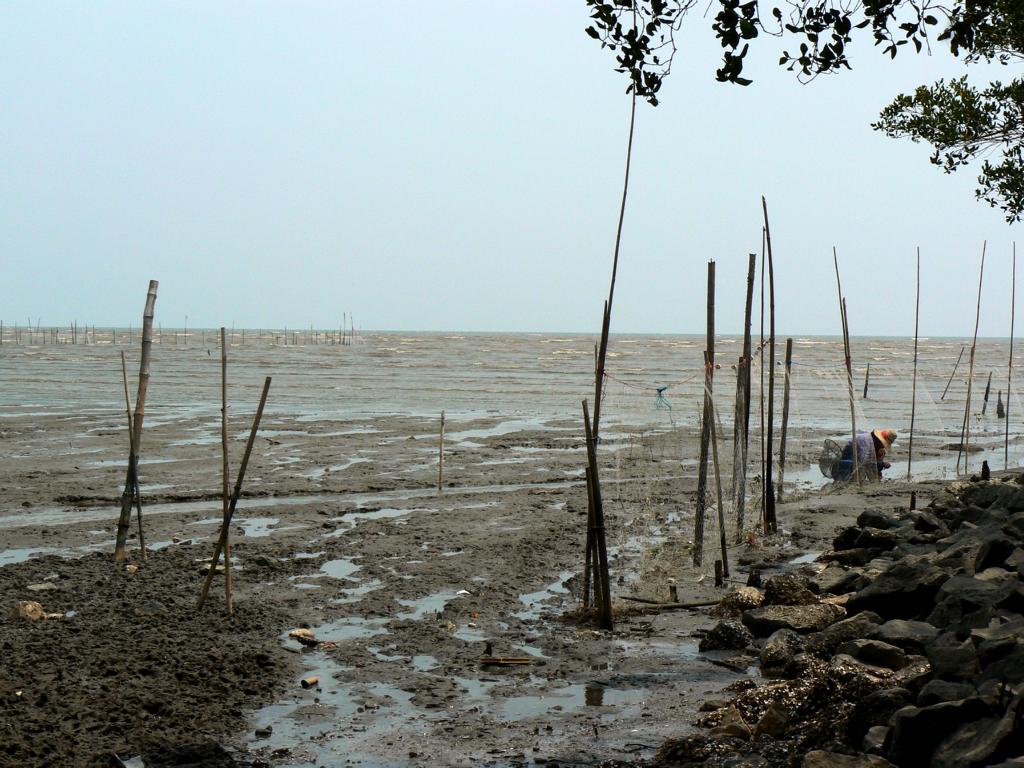
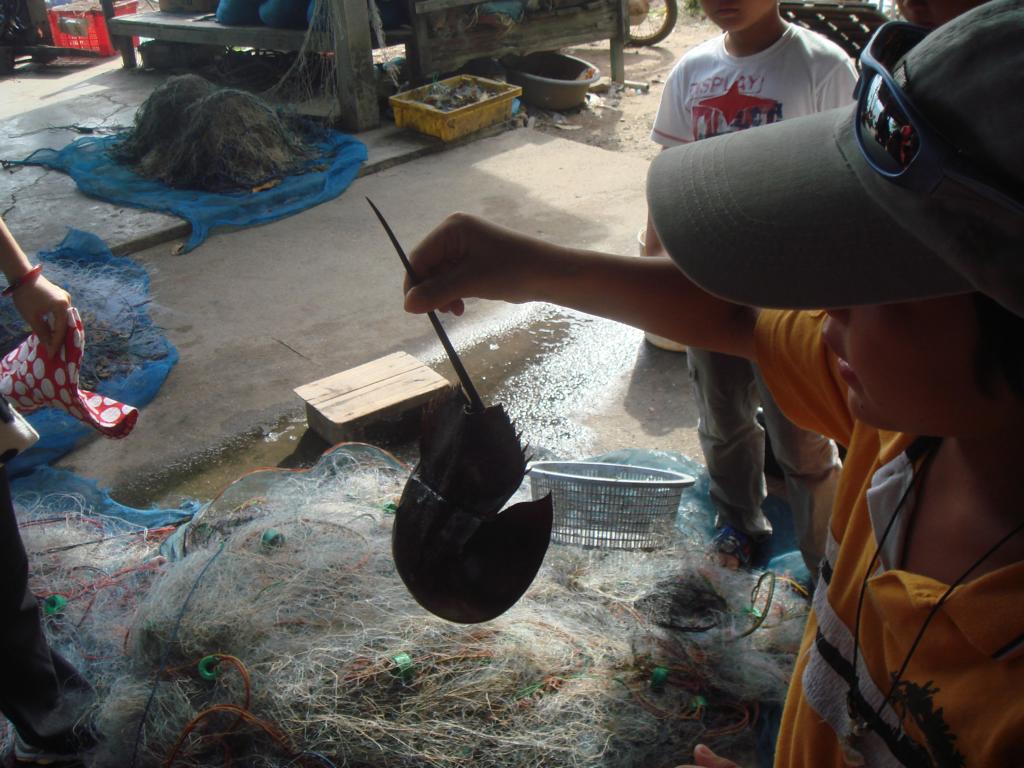
Catching with nets
Another technique for catching horseshoe crabs is using fishing nets. Two common types of nets are set nets and drag nets.
Set nets are strategically placed along the shoreline to intercept horseshoe crabs as they move in shallow waters. These nets can be arranged in different configurations to maximize capture efficiency.
Drag nets, however, drag them through the water in various shapes and sizes. This method allows for a more comprehensive coverage area and is often employed in areas where horseshoe crabs are more dispersed.
In addition to nets, long-handled dip nets or rakes can also be utilized to catch horseshoe crabs. However, these tools are typically practical only in high-visibility waters, such as sandy beaches, where the horseshoe crabs are easily visible and accessible.
The choice of technique depends on factors such as the location, habitat, and water visibility.
Equipment
When manually collecting horseshoe crabs, protecting the entire body from the sun’s rays is essential. This includes wearing a scarf or cloth to cover the head and neck region, providing shade, and minimizing direct exposure to sunlight. Additionally, a wide-brimmed hat is often worn to shield the face, eyes, and neck from the sun.
Wearing protective gloves while handling horseshoe crabs is a common practice to ensure safety and minimize potential injuries. These gloves act as a barrier, shielding the fingers from any stings or pricks caused by the spines on the horseshoe crab’s body.
Indeed, when collecting horseshoe crabs, a box or container is essential to store and transport the captured specimens safely. It is common to utilize a small boat to facilitate the collection process and avoid the need to carry the box over long distances. The boat is a convenient means of transport, allowing collectors to move easily between collection sites without carrying a heavy box.
How to prepare horseshoe crabs for human consumption
In Thailand, when small vendors sell horseshoe crabs for human consumption, they typically employ a two-step cooking process involving boiling and frying. Here’s an overview of the process:
Boiling
The horseshoe crabs are first boiled in a large wok or pot filled with water. The crabs are submerged in boiling water and cooked for approximately 10 minutes. Boiling cooks the eggs and prepares the crabs for further cooking.
Frying
After boiling, the crabs are transferred to a grill or directly placed on hot coals for frying. They are cooked until the carapace, or outer shell, is slightly burnt or charred. This frying process imparts additional flavors and textures to the horseshoe crabs.

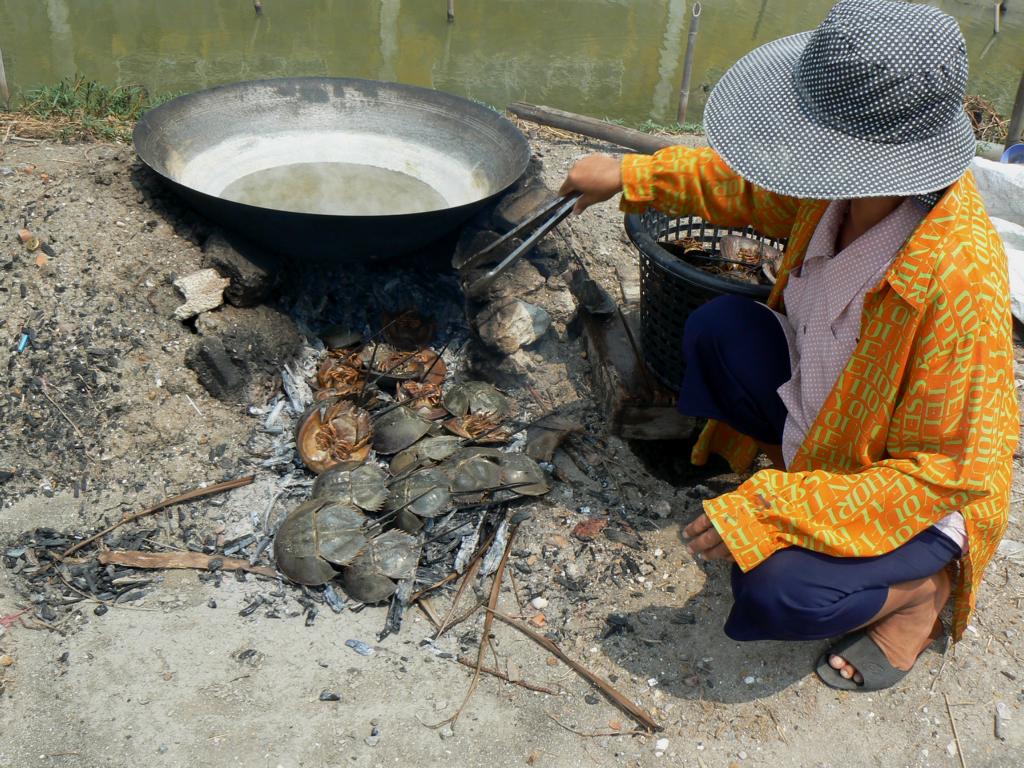


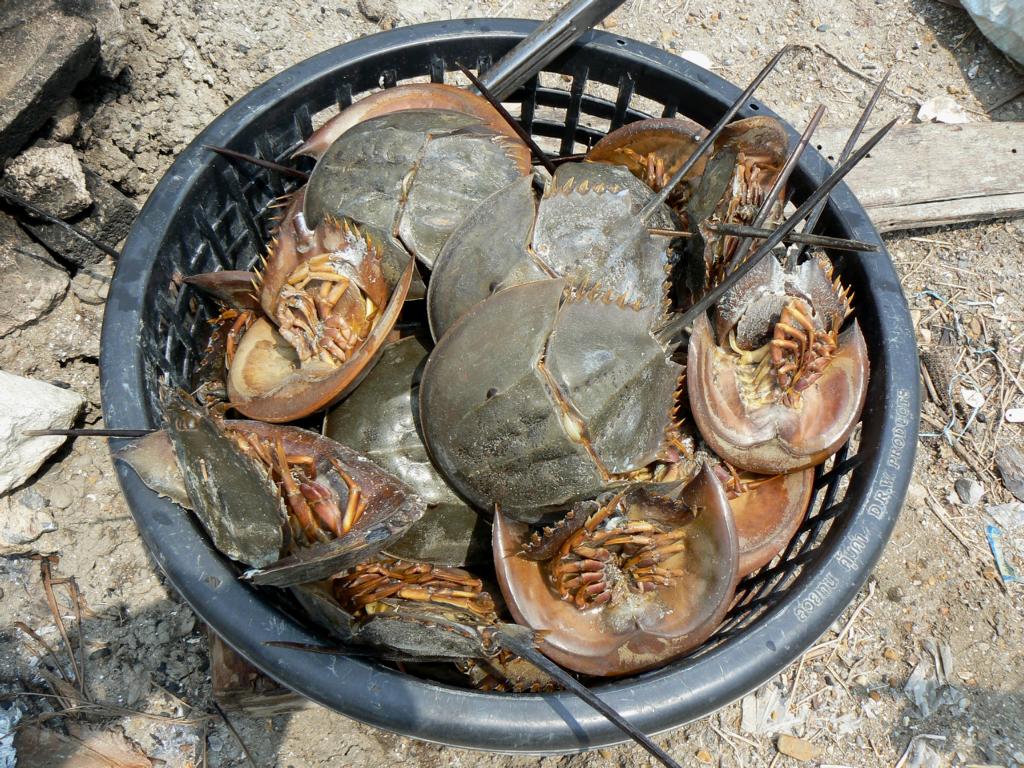
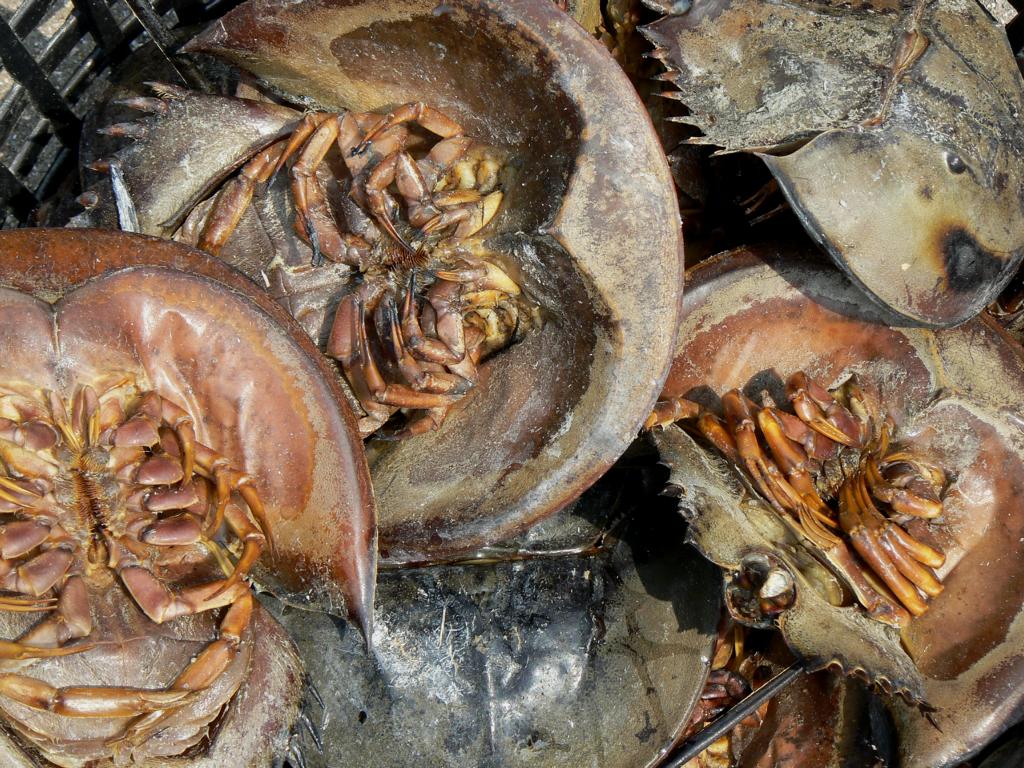
Typically, cooked and fried horseshoe crabs are offered and sold in their entirety without being further processed or dissected. However, in some cases, vendors may showcase the roe, the sought-after delicacy. This is done by cutting open one or two horseshoe crabs along the lower rim of the head to expose and display the roe.
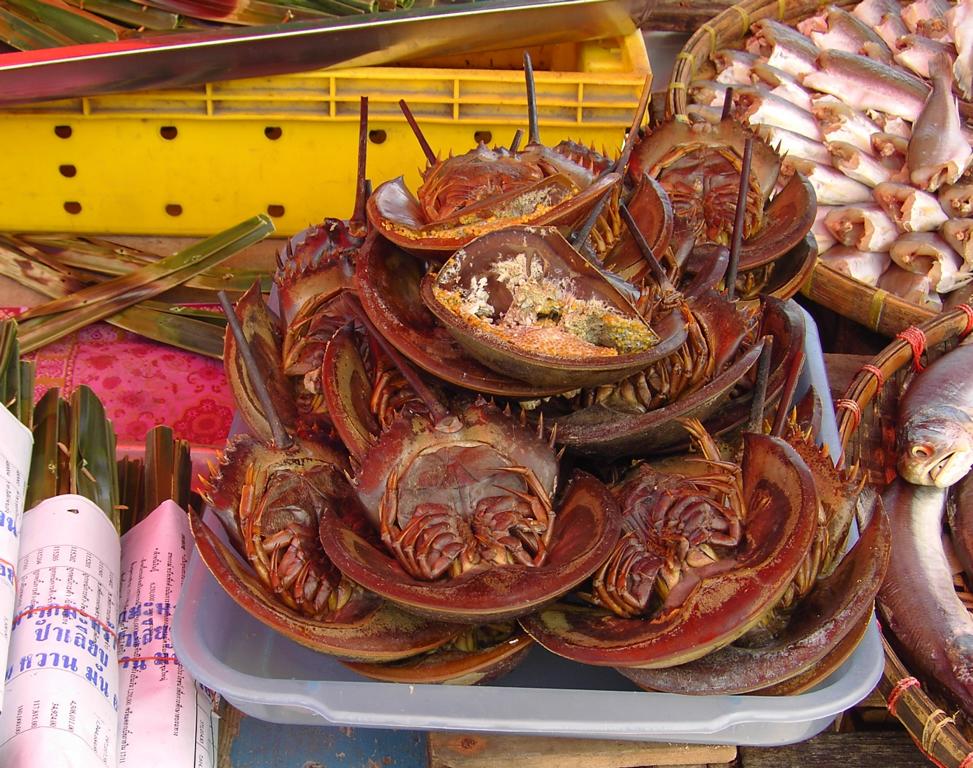
Opening the underside of horseshoe crabs
The remaining flap can be gently pulled backward after making an incision around the inner edge of the leathery skin. This action exposes the eggs encased in a spongy egg-white substance. Alongside the eggs, one will find small muscles, the gizzard, and the long, white gut sac.
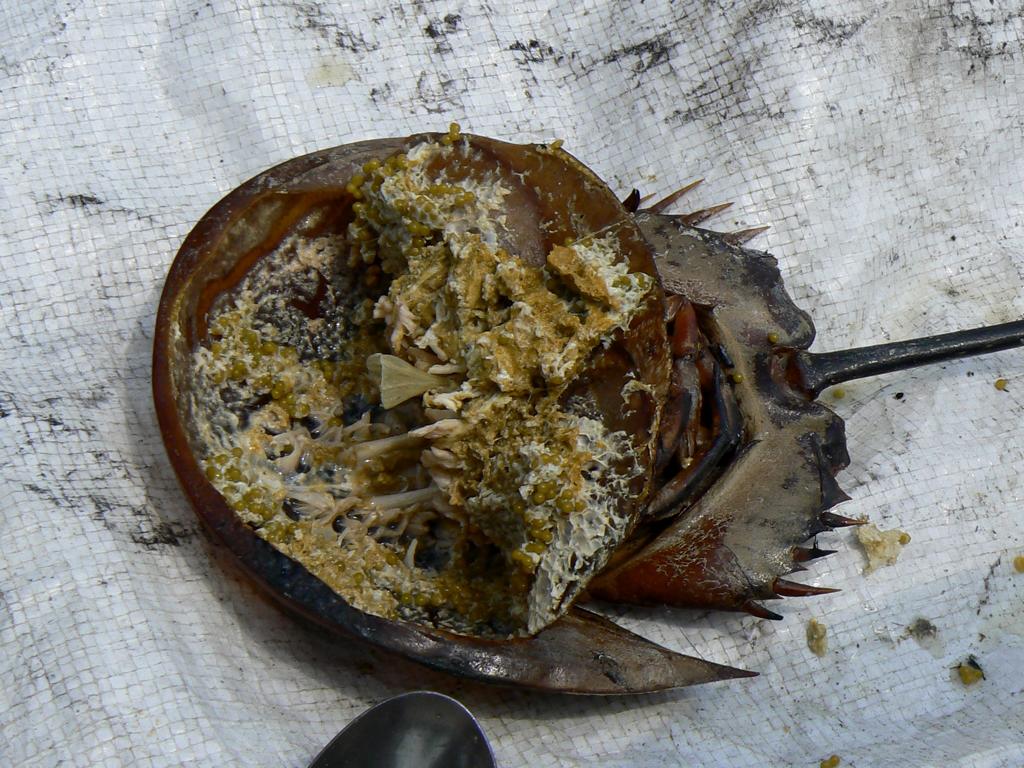
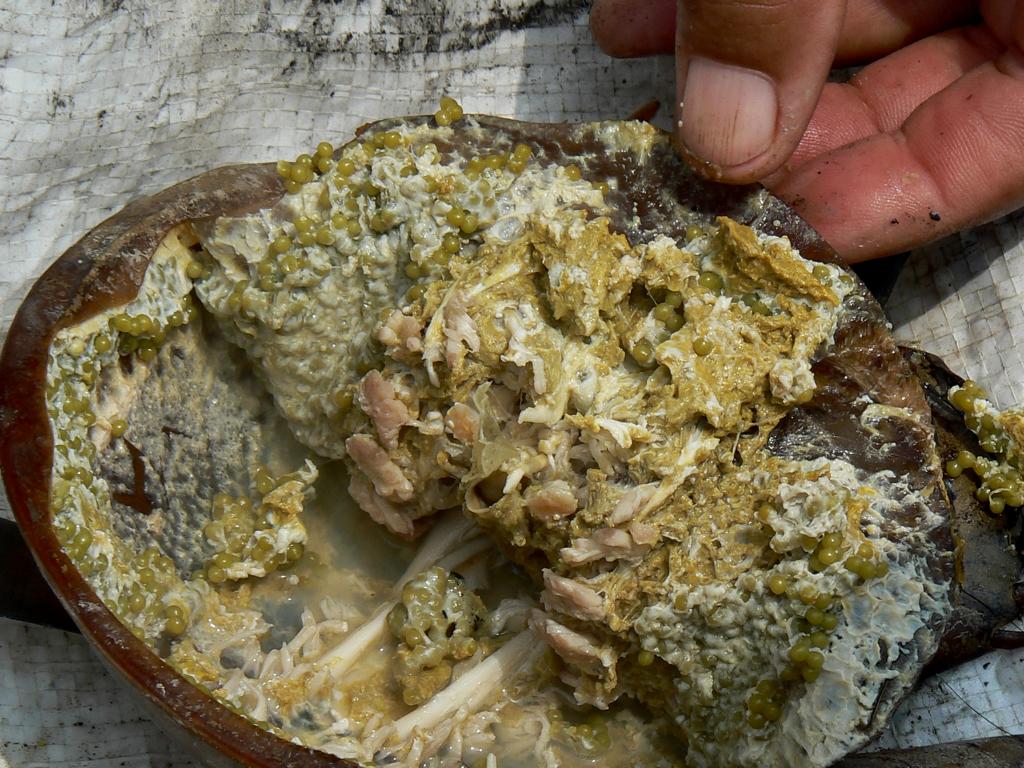


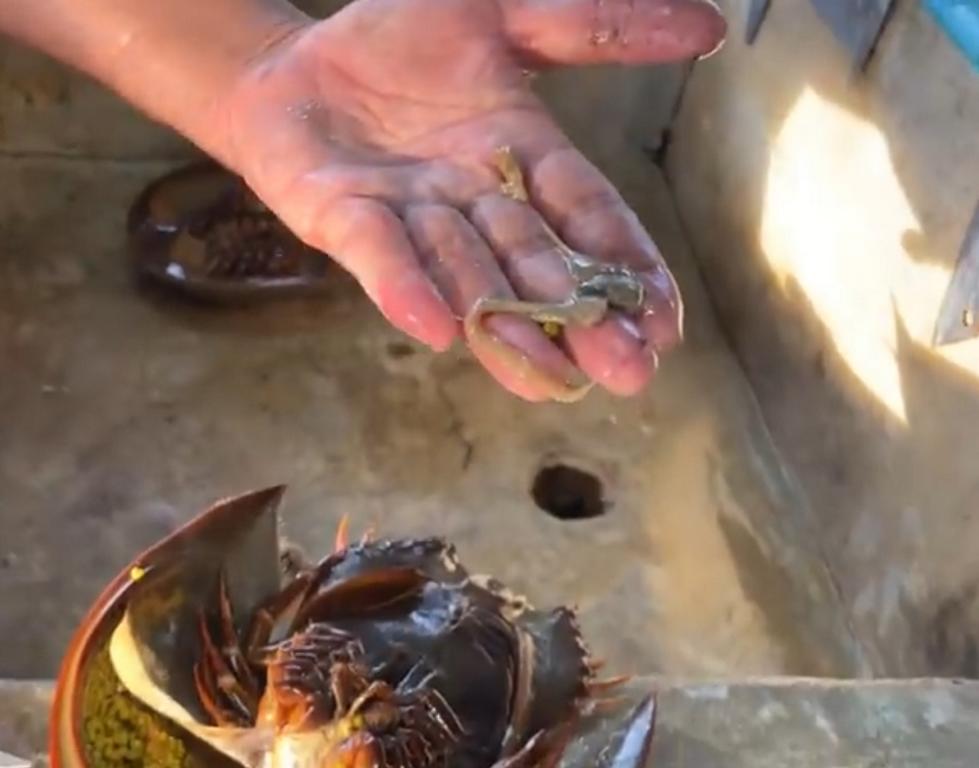
Video stills were obtained from this source.
The location of these internal organs can be seen in the attached illustration. The gullet and gut sac, which are elastic muscles within the horseshoe crab, must be removed and discarded during preparation. These organs are considered inedible and even slightly poisonous.
However, the neighboring yellow-greenish eggs embedded in the egg-white material are the desirable part of the horseshoe crab for culinary purposes. These eggs are carefully scooped out and used in various dishes.
When handling horseshoe crabs for consumption, it is important to differentiate between the edible eggs and the inedible organs. Proper removal and disposal of the gullet and gut sac ensure that only the desired eggs are utilized in culinary preparations.
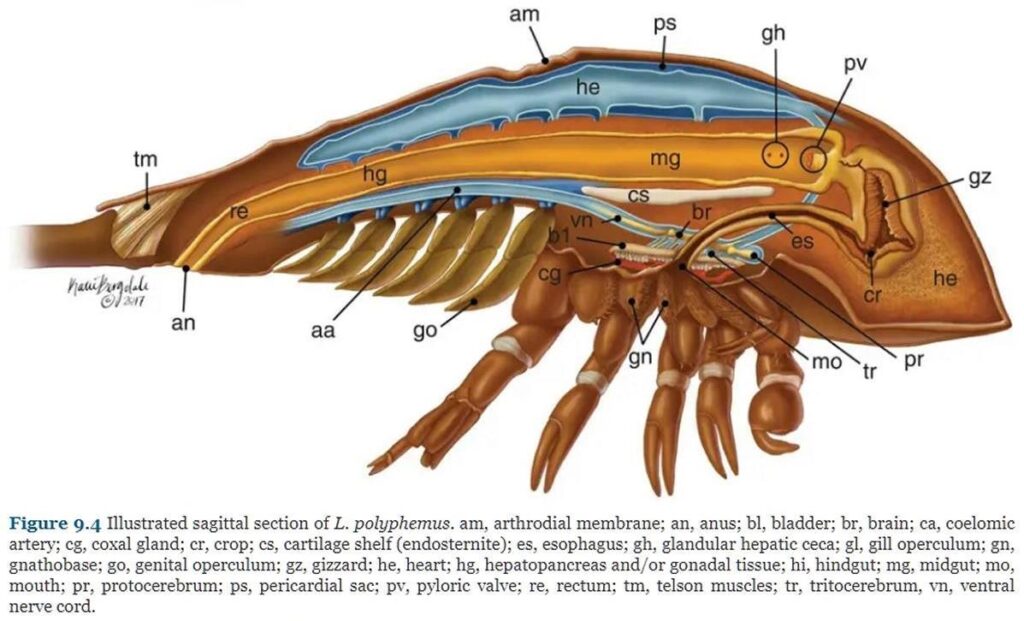
Source: This link. Illustration by Katie J. Roorda, Bergdale (2017)
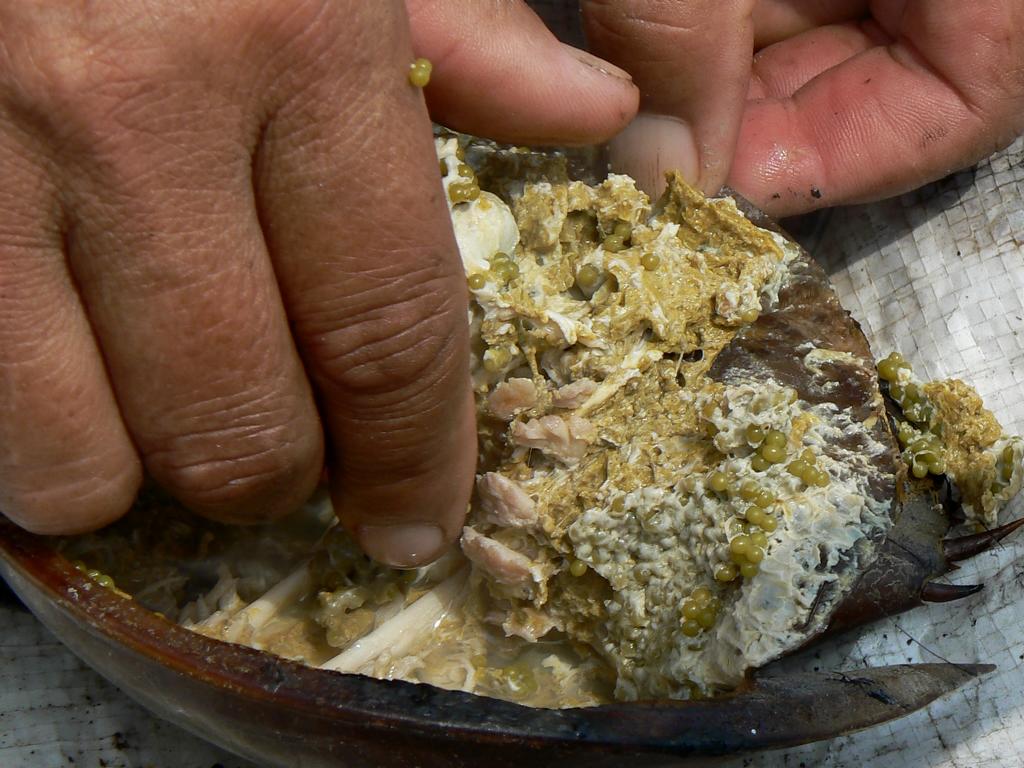
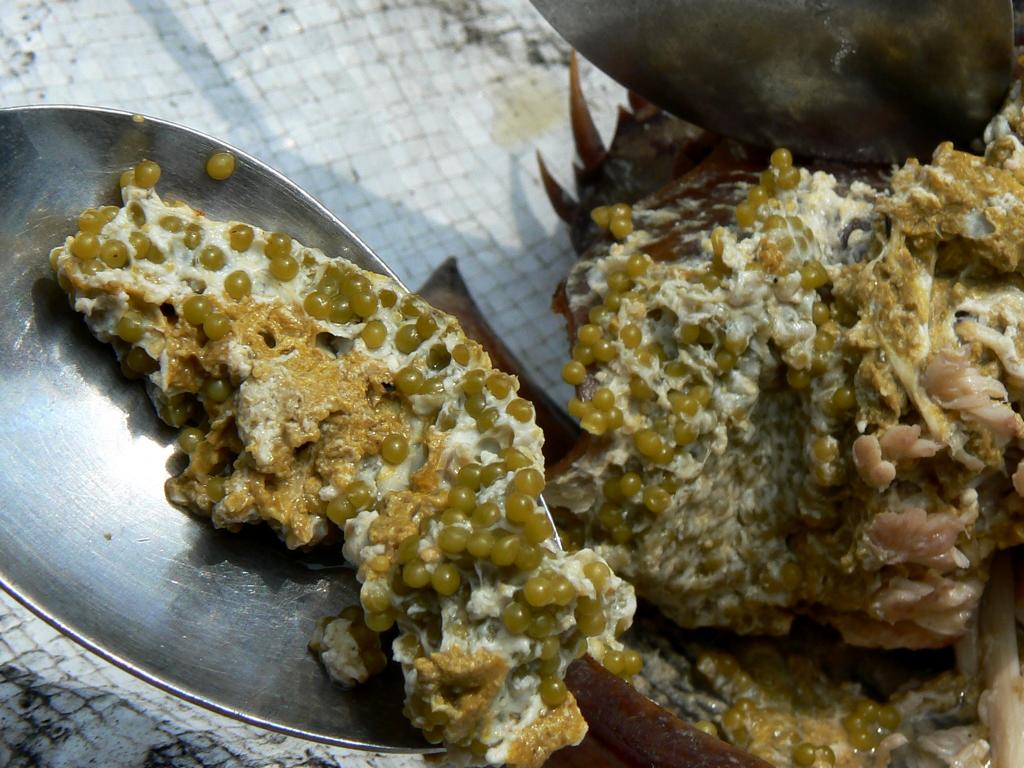
My favorite horseshoe crab dish
Although horseshoe crabs have limited flesh, their roe is highly valued as a delicacy. The eggs are known for their unique texture—crunchy when bitten open. However, when crushed between the teeth, they release a robust fishy flavor that some connoisseurs appreciate.
In Thailand, horseshoe crab roe is commonly featured in a salad called “Yam khai maeng da” (ยำไข่แมงดา). This salad consists of cleaned horseshoe crab eggs, with the egg-white removed, mixed with Som Tam salad. Som Tam is a traditional Thai papaya salad with spicy, sweet, and sour flavors. The combination of the horseshoe crab roe with the vibrant flavors of Som Tam creates a unique and flavorful dish. One example of such a recipe can be found below. The original recipe in the Thai language was published under this link. Also, both pictures of the final dish were published by Muhoro.net (see this link) and not by the author of this article.
‘Spicy Horseshoe Crab Egg Salad


This is a must-try dish that I always order when dining out, as I’m hesitant to prepare it at home.
Ingredients (serves 4-6):
- 2 horseshoe crabs
- 1 unripe mango (preferably sour)
- 10-15 red chili peppers
- 1 bunch of celery
- 5-6 shallots
- Skewered prawns or dried prawns, as desired
- 1 package of cashew nuts
- 1-3 lemons
- 1-3 tablespoons of fish sauce
- Palm sugar syrup
Preparation method
Shop for horseshoe crabs with lots of eggs. Steam the horseshoe crabs until cooked, then grill them over a fire until fragrant. Use a knife to cut the stomach along the edge of the carapace. Then, pull out the gut sac and use a spoon to scrape off the eggs.
Prepare the vegetables for salad. Wash all the vegetables and drain the water. Cut shallots, celery, and chilies into a mixing bowl. Scrape the mangoes into strips with a knife and add them. Add a spoon of syrup. Followed by three tablespoons of fish sauce, followed by lime, mix well. Taste the flavor before giving it a taste of sweet, sour, and salty. Once the taste is right, add horseshoe crab eggs, cashew nuts, and dried shrimp. Mix well, and you can scoop and serve. Be ready to eat spicy!!️!!’
Lessons learned about edible horseshoe crabs:
- Horseshoe crabs can be collected for food without a permit in Thailand.
- It is crucial to exercise great care and ensure the collection of Indo-Pacific horseshoe crabs, specifically while avoiding the Mangrove species.
- The horseshoe crab’s poison, which shares a similar composition to that of pufferfish, is not destroyed by heat.
- Before removing the eggs, all white-colored internal organs must be removed.
- Consuming horseshoe crabs, including their roe, is nowadays not considered a sustainable practice anymore and should be avoided.
Further readings about Crustaceans (although Horseshoe ‘crabs’ are not Crustaceans, but Merostomata) on this website:
Spearing of African blue swimming crabs
Catching mud crabs at Koh Lanta
Catching Ghost crabs by digging
Three-spot swimming crabs on surf-beaten sandy beaches
.


